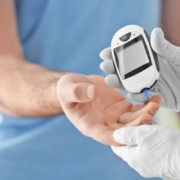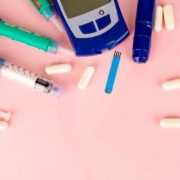The Type 2 Diabetes Meal Planner
Everyone who has diabetes should have a diabetes meal plan. The reason is that certain foods can seriously raise blood sugar levels and make diabetes more difficult to control. In addition, by having a Type 2 diabetes meal plan, you can not only control your blood sugar levels but depend less on medications, which can result in significant cost savings.
When you consume excess calories that include simple sugars and fats, it results in an undesirable increase in blood sugar levels. If this glucose remains high persistently, it can lead to long-term complications of diabetes that include loss of vision, neuropathy, malfunction of the kidneys, premature heart disease, stroke, loss of limb, or even death.
By eating a healthy diet, you can help maintain a safe level of blood glucose and reduce the risk of Type 2 diabetes complications.
Why Is A Diabetic Meal Plan Essential?
There is ample evidence showing that a healthy eating plan has the following benefits:
- Controls your blood sugar levels.
- Helps manage your weight.
- Reduces the risk of high blood pressure and hypercholesterolemia.
- Enhances the quality of life.
- Lowers the need to use diabetic medications.
There is ample literature on the internet offering information as to how to create a Type 2 diabetes meal plan or you can speak to your healthcare provider, dietitian, or diabetic nurse. In the simplest terms, a diabetic meal plan usually means that you eat healthy foods in moderate amounts and adhere to your mealtimes. To help you get started on finding an effective diabetic meal plan, here are some vital tips:
- The diabetic meal plan should focus on foods that are low in calories and fat, and rich in nutrients and vitamins.
- Foods in a Type 2 diabetes meal plan should include veggies, fruits, and whole grains.
- You need to rigidly keep track of your eating habits. This means you should avoid eating outside of your mealtimes.
- A healthy diabetic meal plan can help you lose weight. By losing weight, most diabetics will quickly note that managing blood glucose levels becomes a lot easier.
- The loss in body weight also makes it easier to control blood pressure and lowers cholesterol.
What Does The Diabetic Meal Plan Involve?
The diabetic meal plan requires that you eat three healthy meals a day at set times. This type of diet plan will help your body utilize the insulin that is produced or require less of a diabetic medication to control the blood sugar levels.
Who Can Help Me With A Diabetic Meal Plan?
In most cases, a consultation with a dietitian is helpful. These professionals can help create a Type 2 diabetes meal plan based on your lifestyle, health goals, and tastes. At the same time, a dietitian can teach you how to improve your eating habits by selecting the right food portion that meets the needs of your physical activity and body size.
What Foods Are Recommended In A Type 2 Diabetes Plan?
Complex carbohydrates. Instead of consuming simple carbohydrates (sugars), one should consume complex carbohydrates that contain starch. These include:
- Vegetables
- Fruits
- Whole grains
- Low-fat dairies like cheese, yogurt, and milk
- Legumes, such as peas and beans
Avoid consuming simple carbohydrates, such as foods or beverages with added sugars, fats, and sodium.
Fiber-Rich Foods
You should also consume fiber-rich foods because they help lower blood glucose levels, regulate your bowel movements, and assist with digestion. Fiber-rich foods include:
- Fruits
- Vegetables
- Legumes, like peas and beans
- Nuts
- Whole grains
Fish For Heart Health
You should plan to include fish at least twice a week. It is well known that fish like tuna, mackerel, salmon, and sardines are rich in omega fatty acids, which are known to prevent heart disease and stroke. At the same time, avoid fish that is fried. Some ocean fish, such as mackerel, have been known to contain heavy metals and should be avoided. Always select fresh fish from the local rivers and lakes.
Unsaturated Foods (or Good Fat)
Foods that contain unsaturated fatty acids are known to reduce the levels of cholesterol. Such foods include:
- Nuts
- Avocado
- Olive, canola, and peanut oils
Use these oils sparingly as they are very high in calories.
Foods That You Should Avoid
Diabetics are known to develop premature heart disease and stroke because the blood vessels quickly become clogged with fats. Foods that you should avoid include the following:
- Saturated fats can be found in beef, pork, animal skin, bacon, sausage, and butter. At the same time, limit the intake of palm kernel and coconut oils.
- Trans fats should also be avoided and are usually found in processed food, margarine, baked goods, desserts, and even ice cream.
- Cholesterol is often the cause of atherosclerosis, and foods containing a lot of cholesterol should be limited. Cholesterol-rich foods include egg yolks, animal meat, pork, bacon, and liver. Try and limit the intake of cholesterol to no more than 200 mg/day.
- Finally, limit the intake of sodium to no more than 2,300 mg/day. If you have high blood pressure, then the amount should be less than 1,500 mg/day.
Developing The Meal Plan
Now that you know what you can and cannot eat, you need to make a plan as to how you will eat the food to better contend with Type 2 diabetes.
The plate method: The American Diabetes Association (ADA) has the simplest meal plan, and it focuses more on eating veggies than any other food. The ADA plan is as follows:
- Half your plate should contain non-starchy vegetables, like carrots, spinach, tomatoes, etc.
- A quarter of the plate should include a protein, like lean pork, tuna, or chicken.
- The last quarter of the plate should contain whole grain, like brown rice, quinoa, or a starchy vegetable like beans/peas.
- Sprinkle small amounts of good fats, like avocados and nuts.
- Serve the food with a drink of water, dairy product, fruit juice, or unsweetened tea or coffee.
Count The Calories
It is important not to overeat as this is often a cause of obesity and insulin resistance. A male should eat no more than 2,000 calories per day and a female should eat no more than 1,800 calories per day. All excess calories are converted into body fat which defeats the purpose of a Type 2 diabetes meal plan.
Learn To Read Labels
All diabetics should learn to read labels that will reveal the amount of salt, sugar, carbohydrates, and total calories in products. While this may sound overwhelming, it can significantly help improve your dietary habits and make diabetes much easier to control. A dietitian can educate you on how to read the food labels and measure food portions. At the same time, the dietitian can help you manage the insulin dose based on the amount of your meal.
Glycemic Index
Some diabetics use the glycemic index to select their carbohydrate foods. The glycemic index ranks carbohydrates containing foods based on how they will affect the levels of blood glucose.
A Typical Menu Sample
A typical diabetic meal plan for an adult who consumes 1,600-1,800 calories per day is shown below.
- Breakfast could include a slice of whole-wheat bread with 2 teaspoons of jam/jelly, half a cup of whole cereal with a cup of 1 percent low-fat milk. The beverage may include tea or coffee. A few slices of fruit would be good as well.
- Lunch may include a tuna sandwich on wheat bread with tomatoes, lettuce, low-fat cheese, and mayonnaise (or you could substitute yogurt for the mayo). The beverage may be fruit juice or water. A few slices of fruit can also be consumed.
- Dinner may include a meat dish, a small baked potato, a whole wheat roll, and half a cup of mixed veggies. The beverage may include fruit juice, milk, or tea. Fruit slices can be consumed as a dessert.
- If you still feel hungry, then you can consume popcorn, unsalted crackers, or a variety of nuts.
Conclusion
If you have diabetes, then you must work closely with your primary care provider and a dietitian to develop a meal plan that suits your needs. By eating healthy and limiting the food portions, you will have more stable blood glucose levels after most meals. Eventually, this will reduce the risk of diabetic complications and save you an enormous amount of money in healthcare costs and you will feel better and have more energy. Contact us today for more information.








